Measuring the Industry 5.0-Readiness Level of SMEs Using Industry 1.0–5.0 Practices: The Case of the Seafood Processing Industry
Abstract
1. Introduction
2. Seafood Processing Industry in Thailand
3. Literature Review
3.1. Industrial Revolution 3.0 and Seafood Processing Industry
3.2. World Bank Approach for Assessing Adoption of Industry 4.0 in Food Processing SMEs
3.3. Industrial Revolution 4.0 and Seafood Processing Industry
3.4. Industrial Revolution 5.0 and Seafood Processing Industry
4. Research Method
5. Research Findings
5.1. Industry 1.0 Practice Level
5.2. Industry 2.0 Practice Level
5.3. Industry 3.0 Practice Level
5.4. Industry 4.0 Adoption Level
5.5. Industry 5.0 Readiness Level
6. Findings, Discussion, and Conclusions
Author Contributions
Funding
Institutional Review Board Statement
Informed Consent Statement
Data Availability Statement
Acknowledgments
Conflicts of Interest
Appendix A
| Label | Levels | 0 | 1 | 2 | 3 | 4 | 5 |
|---|---|---|---|---|---|---|---|
| Industry 1.0 (Obsolete—0, Decline—1, Intermediate—2, Slow-rising practice—3, Fast-rising Practice—4, Peak Practice—5) | |||||||
| I1.01 | manual or semi-mechanized production using steam pressure and hot liquids for sterilization (kill microorganisms). | ||||||
| I1.02 | Using coal as an energy source in the production process. | ||||||
| I1.03 | Using sun drying methods. | ||||||
| I1.04 | Using manual hermetic sealing process. | ||||||
| I1.05 | Only oral communications are used to instruct the employees on day-to-day operations. | ||||||
| Industry 2.0 (Obsolete—0, Decline—1, Intermediate—2, Slow-rising practice—3, Fast-rising Practice—4, Peak Practice—5) | 0 | 1 | 2 | 3 | 4 | 5 | |
| I2.01 | Producing in mass using semi-automatic assembly lines. | ||||||
| I2.02 | Using petroleum products for production process (Diesel/Kerosene/LPG) as an energy source in the production process. | ||||||
| I2.03 | Applying chemical compositions in drying, freezing, and pasteurization. | ||||||
| I2.04 | Using refrigerators and oven for freezing, storing, and drying. | ||||||
| I2.05 | Using semi-automatic machineries in the production process. | ||||||
| I2.06 | Practicing division of labor in food processing, preservation, and other functional departments. | ||||||
| I2.07 | Using written communication to provide instructions without a standard format (TQM/Quality Management Systems). | ||||||
| Industry 3.0 (Outsider—0, Beginner—1, Intermediate—2, Experienced—3, Expert—4, Leading performer—5) | 0 | 1 | 2 | 3 | 4 | 5 | |
| I3.01 | Using electronically automated machineries for seafood and seafood products processing. | ||||||
| I3.02 | Using renewable energy sources in the organization. | ||||||
| I3.03 | Using programmed/computerized machineries in processing (sterilization, freeze-drying, drying). | ||||||
| I3.04 | Using advanced equipment in freezing. | ||||||
| I3.05 | Using vacuum packaging for preservation of seafood and seafood products. | ||||||
| I3.06 | Using modern packaging technology. | ||||||
| I3.07 | Using digital printing on packages. | ||||||
| I3.08 | Using food laboratories along with anyone of the following applications such as computers, advanced equipment, biotechnology, and nanotechnology. | ||||||
| I3.09 | Using new technologies and the internet in all functional areas of business management. | ||||||
| I3.10 | Using software or work order system in the firm for communication. | ||||||
| Industry 4.0 (Outsider—0, Beginner—1, Intermediate—2, Experienced—3, Expert—4, Leading performer—5) | 0 | 1 | 2 | 3 | 4 | 5 | |
| I4.01 | Usage of automated machineries. | ||||||
| I4.02 | Usage of a fully digitalized manufacturing process. | ||||||
| I4.03 | Usage of robots in the production line (picking, moving, and placing). | ||||||
| I4.04 | Usage of robotic machineries in processing. | ||||||
| I4.05 | Usage of eco-friendly extraction technologies. | ||||||
| I4.06 | Usage of high-pressure processing technologies. | ||||||
| I4.07 | Usage of thermal and non-thermal processing and preservation technologies. | ||||||
| I4.08 | Usage of automatic canning/packaging machineries. | ||||||
| I4.09 | Usage of vacuum processing and packaging machines. | ||||||
| I4.10 | Usage of smart labelling (RFID). | ||||||
| I4.11 | Usage of sensory and texture analyzing machineries. | ||||||
| I4.12 | Usage of artificial intelligence (AI) food sensing technologies for tracing food safety and quality. | ||||||
| I4.13 | Use of ERP systems. | ||||||
| I4.14 | Usage of big data to analyze consumer demand and consumer behavior. | ||||||
| I4.15 | Usage of e-system or software for communicating with internal employees and external suppliers. | ||||||
| Industry 5.0 (Outsider—0, Beginner—1, Intermediate—2, Experienced—3, Expert—4, Leading performer—5) | 0 | 1 | 2 | 3 | 4 | 5 | |
| I5.01 | Using human-centric approach in automated business processes and management practices. | ||||||
| I5.02 | Adopting fair trade practices using business openness, market orientation and traceability throughout the value chain. | ||||||
| I5.03 | Using lean management to effectively manage resources and reduce waste. | ||||||
| I5.04 | Adopt sustainability practices to reduce negative economic, environmental, and social impacts. | ||||||
| I5.05 | Develop/adopt resilience plans to handle economic/environmental disruptions. | ||||||
References
- Madhavan, M.; Sharafuddin, M.A.; Chaichana, T. Impact of Business Model Innovation on Sustainable Performance of Processed Marine Food Product SMEs in Thailand—A PLS-SEM Approach. Sustainability 2022, 14, 9673. [Google Scholar] [CrossRef]
- Simonetto, M.; Peron, M.; Fragapane, G.; Sgarbossa, F. Digital Assembly Assistance System in Industry 4.0 Era: A Case Study with Projected Augmented Reality. In Proceedings of the Advanced Manufacturing and Automation X; Wang, Y., Martinsen, K., Yu, T., Wang, K., Eds.; Springer: Singapore, 2021; pp. 644–651. [Google Scholar]
- SMEs Development Bank of Thailand. Available online: https://www.smebank.co.th/en/news/detail/622 (accessed on 15 December 2022).
- Rada, M. INDUSTRY 5.0—From Virtual to Physical. Available online: https://www.linkedin.com/pulse/industry-50-from-virtual-physical-michael-rada (accessed on 12 December 2022).
- European Economic and Social Committee Industry 5.0 Will Bring about a New Paradigm of Cooperation between Humans and Machines. Available online: https://www.eesc.europa.eu/en/news-media/eesc-info/012019/articles/66151 (accessed on 13 December 2022).
- Müller, J. Enabling Technologies for Industry 5.0: Results of a Workshop with Europe’s Technology Leaders; Results of a Workshop with Europe’s Technology Leaders; European Commission: Luxembourg, 2020. [Google Scholar]
- Directorate-General for Research and Innovation (European Commission); Breque, M.; De Nul, L.; Petridis, A. Industry 5.0: Towards a Sustainable, Human Centric and Resilient European Industry; Publications Office of the European Union: Luxembourg, 2021. [Google Scholar]
- Madhavan, M.; Wangtueai, S.; Sharafuddin, M.A.; Chaichana, T. The Precipitative Effects of Pandemic on Open Innovation of SMEs: A Scientometrics and Systematic Review of Industry 4.0 and Industry 5.0. J. Open Innov. Technol. Mark. Complex. 2022, 8, 152. [Google Scholar] [CrossRef]
- Hein-Pensel, F.; Winkler, H.; Brückner, A.; Wölke, M.; Jabs, I.; Mayan, I.J.; Kirschenbaum, A.; Friedrich, J.; Zinke-Wehlmann, C. Maturity Assessment for Industry 5.0: A Review of Existing Maturity Models. J. Manuf. Syst. 2023, 66, 200–210. [Google Scholar] [CrossRef]
- International Labour Organization. Endline Research Findings on Fishers and Seafood Workers in Thailand; International Labour Organization: Geneva, Switzerland, 2020. [Google Scholar]
- Sowcharoensuk, C. Industry Outlook 2019–2021: Processed Seafood; Krungsri Research: Bangkok, Thailand, 2019; Available online: https://www.krungsri.com/en/research/industry/industry-outlook/food-beverage/processed-seafood/io/io-frocessed-seafood-20-th (accessed on 18 December 2022).
- MOC, Thailand. Available online: https://www.moc.go.th/ (accessed on 18 December 2022).
- Department of Industrial Works|Department of Industrial Works. Available online: https://www.diw.go.th/webdiw/ (accessed on 2 June 2023).
- Suwanrangsi, S. Advances in Fish Processing Technology in Thailand in Relation to Quality Management. In Proceedings of the Seminar on the Advances in Fish Processing Technology in Southeast Asia in Relation to Quality Management, Singapore, 29 October–1 November 1996; Marine Fisheries Research Department, Southeast Asian Fisheries Development Center: Singapore, 1997; pp. 72–93. [Google Scholar]
- Cirera, X.; Comin, D.; Cruz, M.; Lee, K.M.; Soares Martins-Neto, A. Firm-Level Technology Adoption in Vietnam; Policy Research Working Papers; No.9567; The World Bank: Washington, DC, USA, 2021. [Google Scholar]
- Cirera, X.; Comin, D.; Cruz, M.; Lee, K.M. Firm-Level Adoption of Technologies in Senegal; Policy Research Working Papers; WPS9657; The World Bank: Washington, DC, USA, 2021. [Google Scholar]
- Cirera, X.; Comin, D.; Cruz, M. A New Approach to Measure Technology Adoption at the Firm-Level; The World Bank: Washington, DC, USA, 2020. [Google Scholar]
- Chunthasiri, Y.; Intarakamhang, U.; Kongprasert, N.; Carr, S.C.; Young-Hauser, A.M. Causal Model of Talent Utilization, Engagement and Performance among Employees in the Seafood Processing Industry. J. Behav. Sci. 2021, 16, 109–122. [Google Scholar]
- Echegaray, N.; Hassoun, A.; Jagtap, S.; Tetteh-Caesar, M.; Kumar, M.; Tomasevic, I.; Goksen, G.; Lorenzo, J.M. Meat 4.0: Principles and Applications of Industry 4.0 Technologies in the Meat Industry. Appl. Sci. 2022, 12, 6986. [Google Scholar] [CrossRef]
- Hassoun, A.; Siddiqui, S.A.; Smaoui, S.; Ucak, İ.; Arshad, R.N.; Garcia-Oliveira, P.; Prieto, M.A.; Aït-Kaddour, A.; Perestrelo, R.; Câmara, J.S. Seafood Processing, Preservation, and Analytical Techniques in the Age of Industry 4.0. Appl. Sci. 2022, 12, 1703. [Google Scholar] [CrossRef]
- Jideani, A.I.O.; Mutshinyani, A.P.; Maluleke, N.P.; Mafukata, Z.P.; Sithole, M.V.; Lidovho, M.U.; Ramatsetse, E.K.; Matshisevhe, M.M. Impact of Industrial Revolutions on Food Machinery—An Overview. J. Food Res. 2020, 9, 42. [Google Scholar] [CrossRef]
- Hassoun, A.; Prieto, M.A.; Carpena, M.; Bouzembrak, Y.; Marvin, H.J.P.; Pallarés, N.; Barba, F.J.; Punia Bangar, S.; Chaudhary, V.; Ibrahim, S.; et al. Exploring the Role of Green and Industry 4.0 Technologies in Achieving Sustainable Development Goals in Food Sectors. Food Res. Int. 2022, 162, 112068. [Google Scholar] [CrossRef] [PubMed]
- Hassoun, A.; Alhaj Abdullah, N.; Aït-Kaddour, A.; Ghellam, M.; Beşir, A.; Zannou, O.; Önal, B.; Aadil, R.M.; Lorenzo, J.M.; Mousavi Khaneghah, A.; et al. Food Traceability 4.0 as Part of the Fourth Industrial Revolution: Key Enabling Technologies. Crit. Rev. Food Sci. Nutr. 2022, 64, 873–889. [Google Scholar] [CrossRef] [PubMed]
- Akundi, A.; Euresti, D.; Luna, S.; Ankobiah, W.; Lopes, A.; Edinbarough, I. State of Industry 5.0—Analysis and Identification of Current Research Trends. Appl. Syst. Innov. 2022, 5, 27. [Google Scholar] [CrossRef]
- Atwell, C. Yes, Industry 5.0 Is Already on the Horizon. Available online: https://www.machinedesign.com/automation-iiot/article/21835933/yes-industry-50-is-already-on-the-horizon (accessed on 12 December 2022).
- Demir, K.; Cicibaş, H. Industry 5.0 and a Critique of Industry 4.0. In Proceedings of the 4th International Management Information Systems Conference, Istanbul, Turkey, 17 October 2017. [Google Scholar]
- Kumar, R.; Gupta, P.; Singh, S.; Jain, D. Human Empowerment by Industry 5.0 in Digital Era: Analysis of Enablers. In Advances in Industrial and Production Engineering. Lecture Notes in Mechanical Engineering; Phanden, R.K., Mathiyazhagan, K., Kumar, R., Paulo Davim, J., Eds.; Springer: Singapore, 2021; pp. 401–410. [Google Scholar]
- Rada, M. INDUSTRY 5.0 Definition’, Published Year: 2017. Available online: https://www.linkedin.com/pulse/industrial-upcycling-definition-michael-rada (accessed on 12 December 2022).
- Gergin, Z.; Üney-Yüksektepe, F.; Güneş Gençyılmaz, M.; Tülin Aktin, A.; Gülen, K.G.; İlhan, D.A.; Dündar, U.; Cebeci, Ö.; Çavdarlı, A.İ. Industry 4.0 Scorecard of Turkish SMEs. In Proceedings of the International Symposium for Production Research 2018; Durakbasa, N.M., Gencyilmaz, M.G., Eds.; Springer International Publishing: Cham, Switzerland, 2019; pp. 426–437, ISBN 978-3-319-92266-9. [Google Scholar]
- Machado, M.C.; Carvalho, T.C.M. de B. Maturity Models and Sustainable Indicators—A New Relationship. Sustainability 2021, 13, 13247. [Google Scholar] [CrossRef]
- Nowacki, K. Accident Risk in the Production Sector of EU Countries—Cohort Studies. Int. J. Environ. Res. Public Health 2021, 18, 3618. [Google Scholar] [CrossRef] [PubMed]
- Rawan, M.R.M.; Daril, M.A.M.; Wahab, M.I.A.; Subari, K.; Manan, Q.; Parveen, S. The Evolution of Ergonomics Risk Assessment Method to Prevent Work-Related Musculoskeletal Disorders (WMSDS). Int. J. Online Biomed. Eng. (Ijoe) 2022, 18, 87–97. [Google Scholar] [CrossRef]
- Abdul Aziz, F.; Ghazalli, Z.; Mohamed, N. A Web-Based Ergonomics Assessment System for Prioritizing Critical Work-Related Musculoskeletal Disorders Risk Factor. IOP Conf. Ser. Mater. Sci. Eng. 2020, 788, 012024. [Google Scholar] [CrossRef]
- Edgeman, R. Complex Management Systems and the Shingo Model: Foundations of Operational Excellence and Supporting Tools; Productivity Press: New York, NY, USA, 2019; ISBN 978-1-315-22963-8. [Google Scholar]
- Fonda, E.; Meneghetti, A. The Human-Centric SMED. Sustainability 2022, 14, 514. [Google Scholar] [CrossRef]
- Sindhwani, R.; Afridi, S.; Kumar, A.; Banaitis, A.; Luthra, S.; Singh, P.L. Can Industry 5.0 Revolutionize the Wave of Resilience and Social Value Creation? A Multi-Criteria Framework to Analyze Enablers. Technol. Soc. 2022, 68, 101887. [Google Scholar] [CrossRef]
- Lichtblau, K.; Stich, V.; Bertenrath, R.; Blum, M.; Bleider, M.; Millack, A.; Schmitt, K.; Schmitz, E.; Schröter, M. Industrie 4.0 Readiness; IMPULS-Stiftung: Frankfurt, Germany, 2015; pp. 1–78. Available online: https://impuls-stiftung.de/wp-content/uploads/2022/05/Industrie-4.0-Readiness-english.pdf (accessed on 16 December 2022).
- Industrie 4.0-Readiness-Check. Available online: https://www.industrie40-readiness.de/?lang=en (accessed on 2 June 2023).
- Business Type Code Search and Recommendation System—Department of Business Development. Available online: https://tsic.dbd.go.th/index (accessed on 2 June 2023).
- The Office of SMEs Promotion (OSMEP). Available online: https://www.sme.go.th/th/index.php (accessed on 2 February 2024).
- Definition of MSMEs. Available online: https://www.sme.go.th/en/page.php?modulekey=363 (accessed on 2 February 2024).
- National Center for Home Food Preservation|NCHFP Publications. Available online: https://nchfp.uga.edu/publications/nchfp/factsheets/food_pres_hist.html (accessed on 2 June 2023).
- Sharafuddin, M.A.; Madhavan, M.; Chaichana, T. The Effects of Innovation Adoption and Social Factors between Sustainable Supply Chain Management Practices and Sustainable Firm Performance: A Moderated Mediation Model. Sustainability 2022, 14, 9099. [Google Scholar] [CrossRef]
- Martín-Gómez, A.M.; Agote-Garrido, A.; Lama-Ruiz, J.R. A Framework for Sustainable Manufacturing: Integrating Industry 4.0 Technologies with Industry 5.0 Values. Sustainability 2024, 16, 1364. [Google Scholar] [CrossRef]
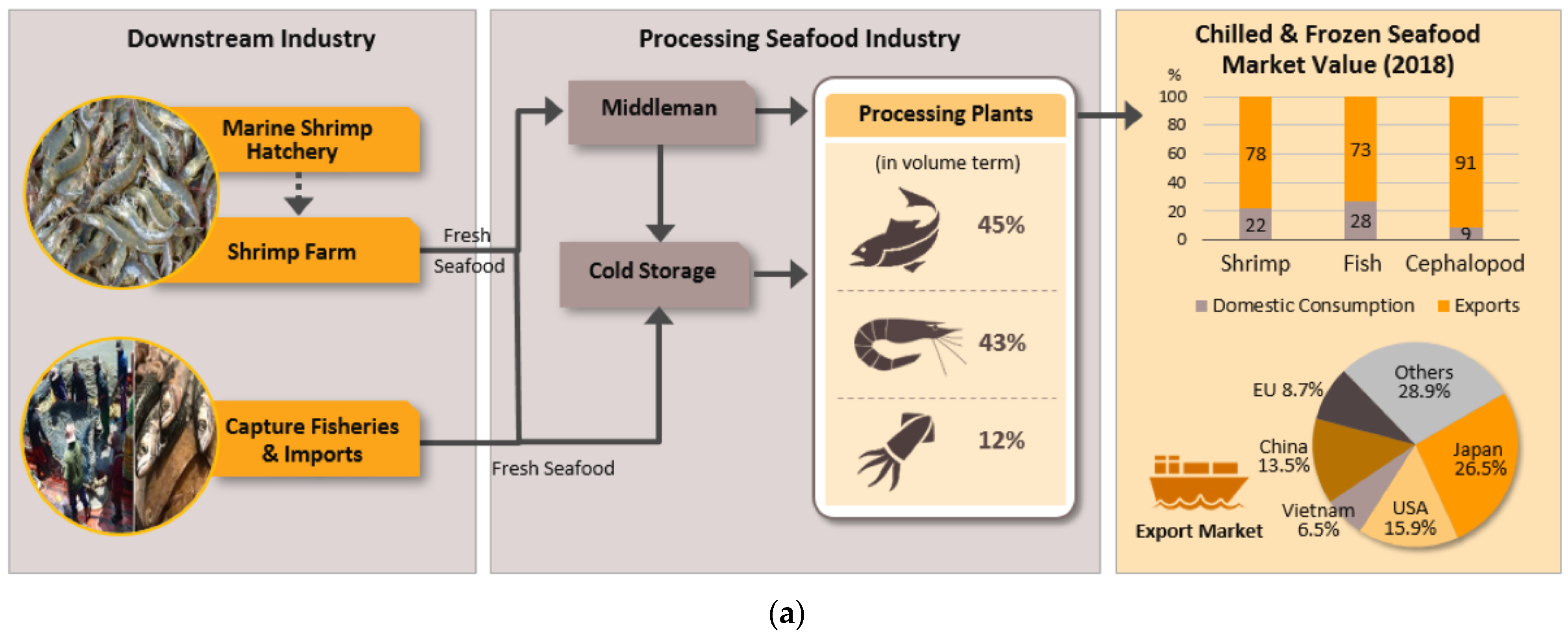
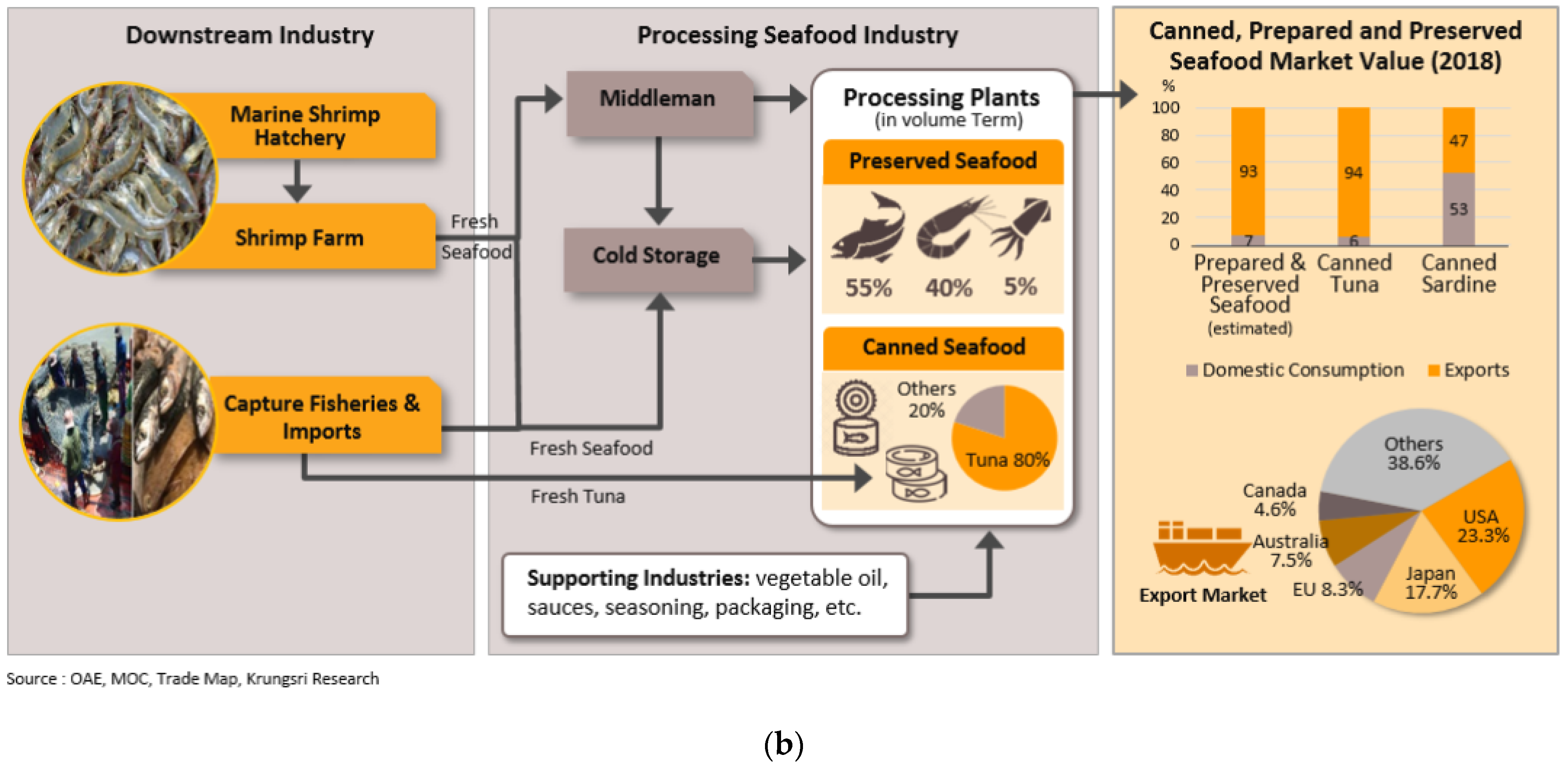
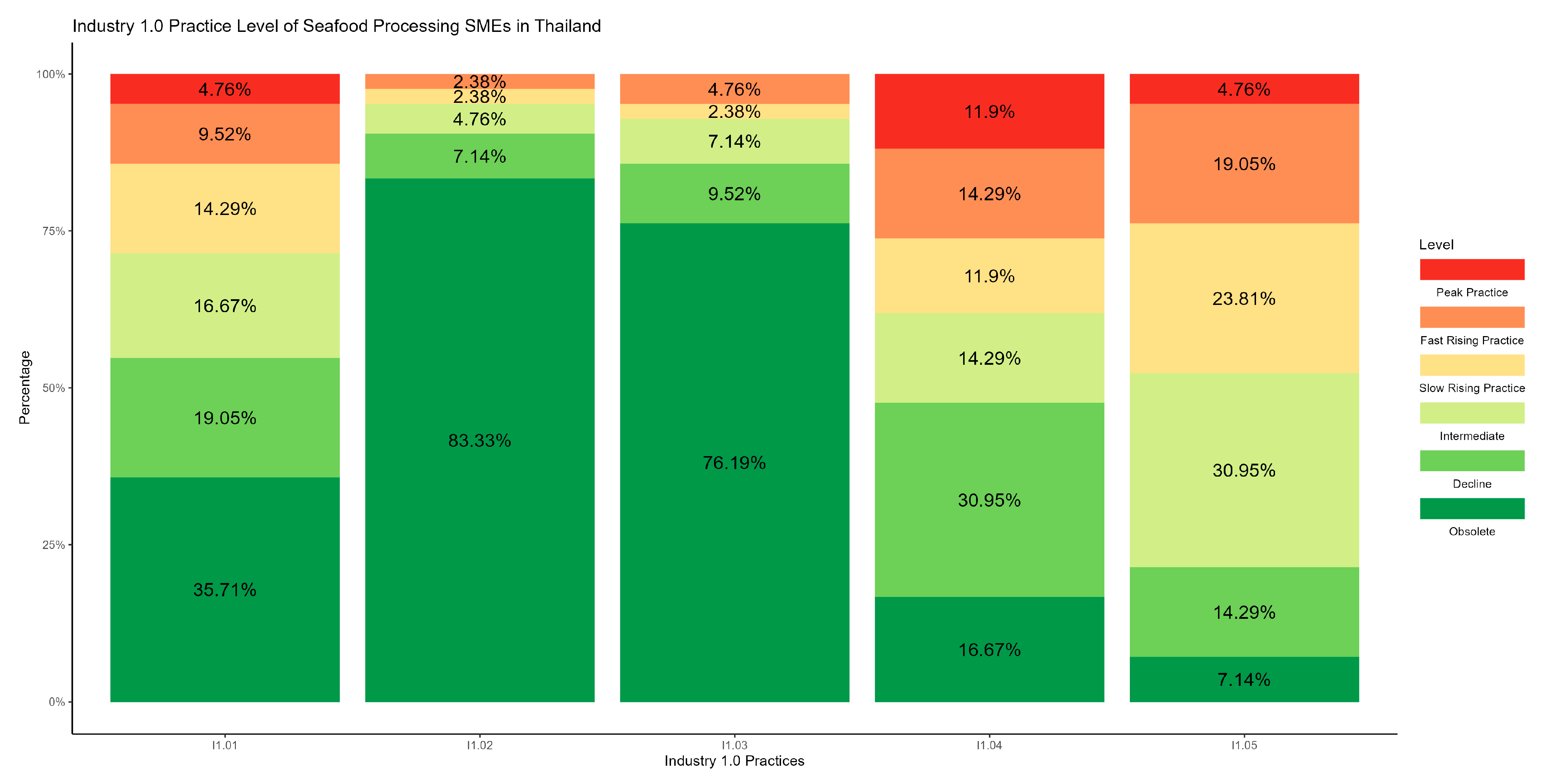
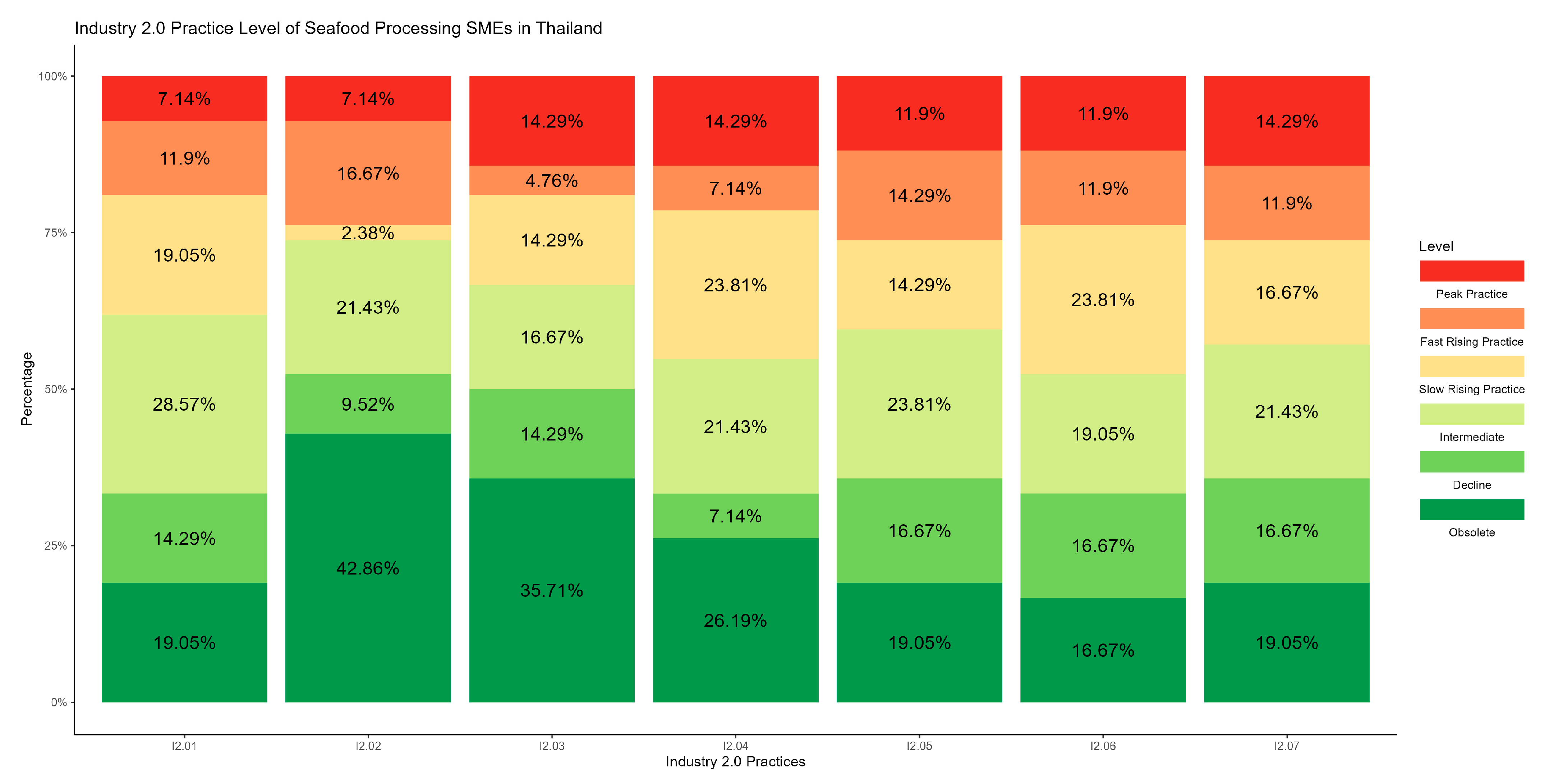
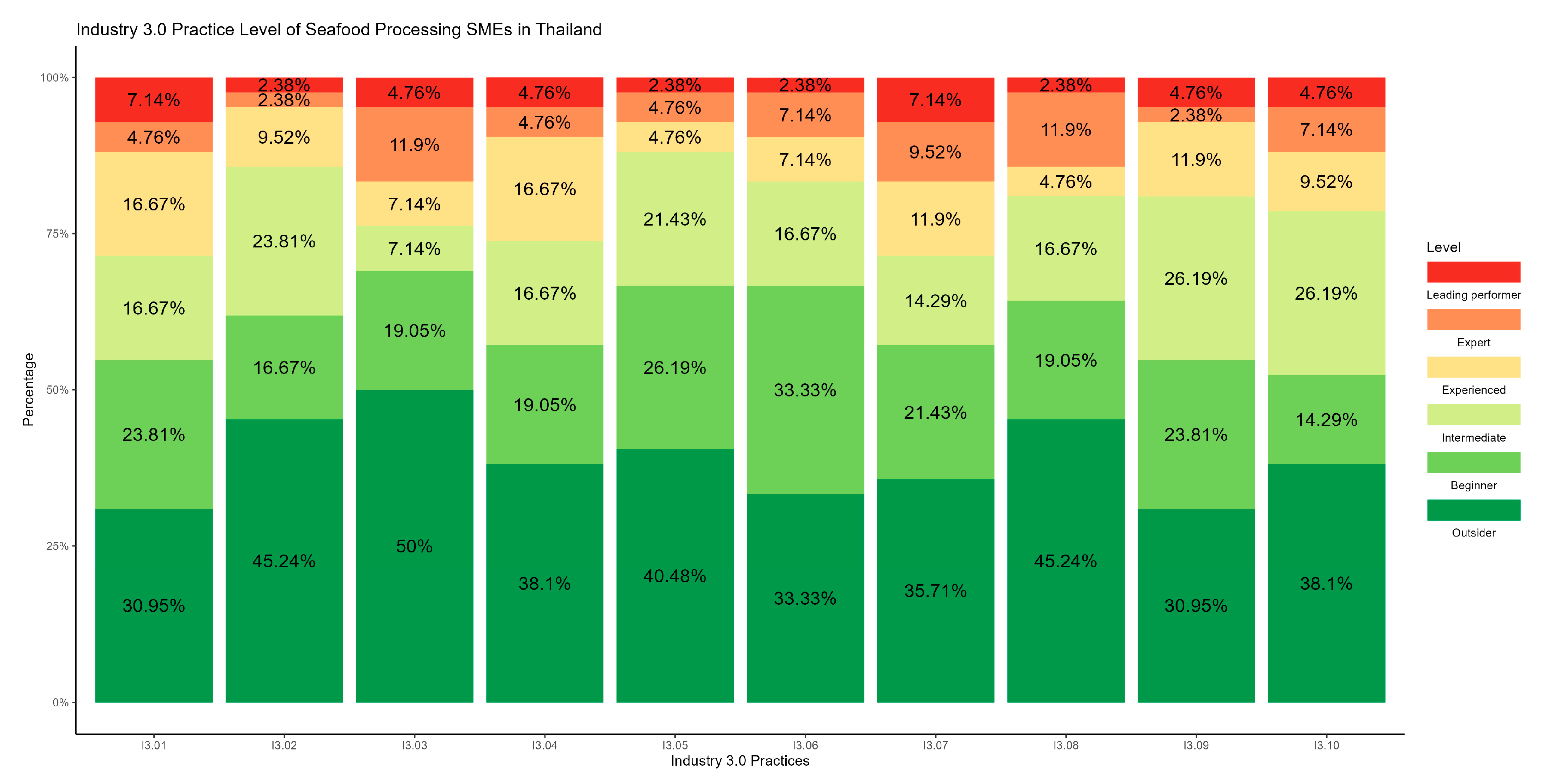
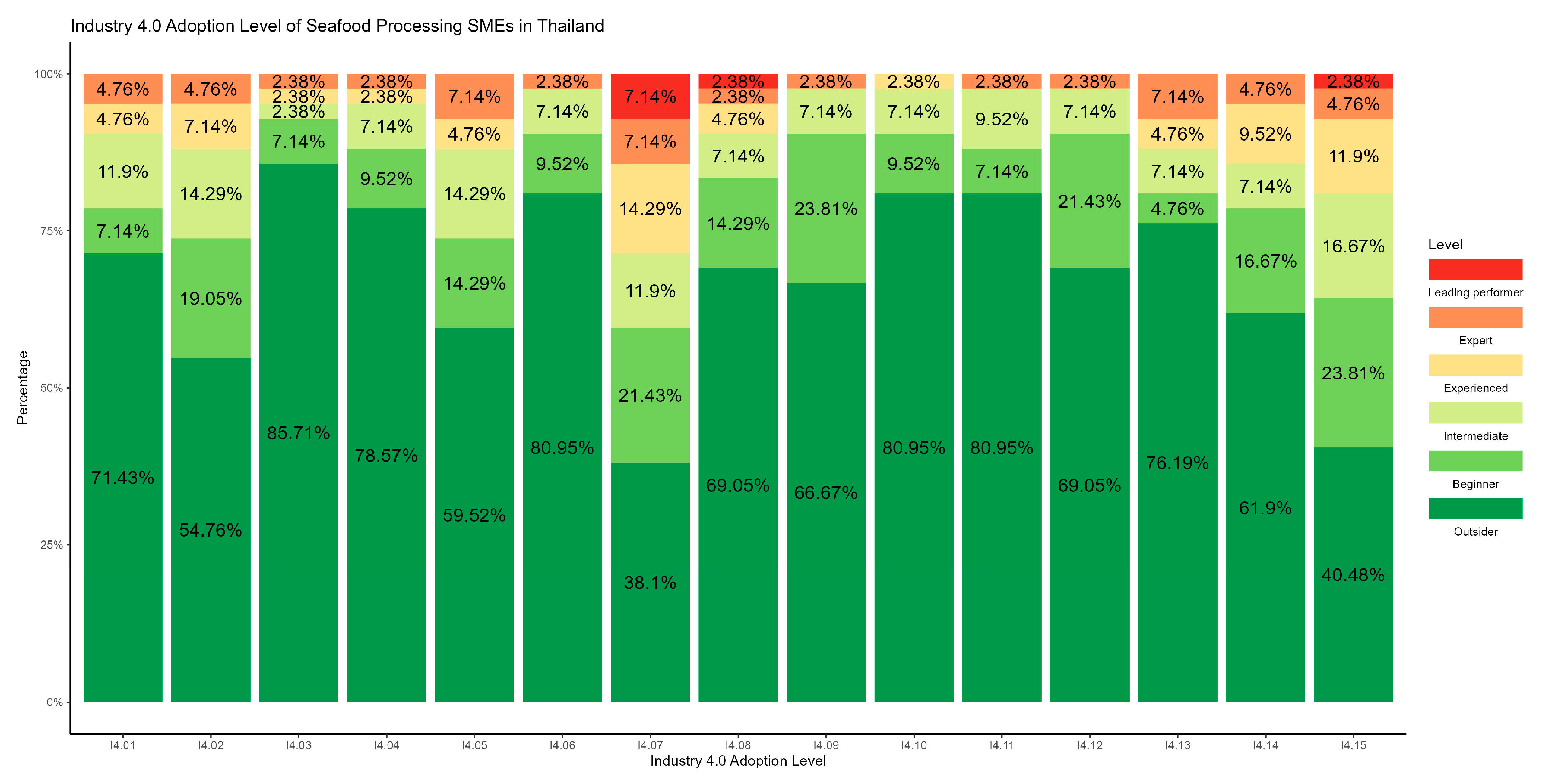
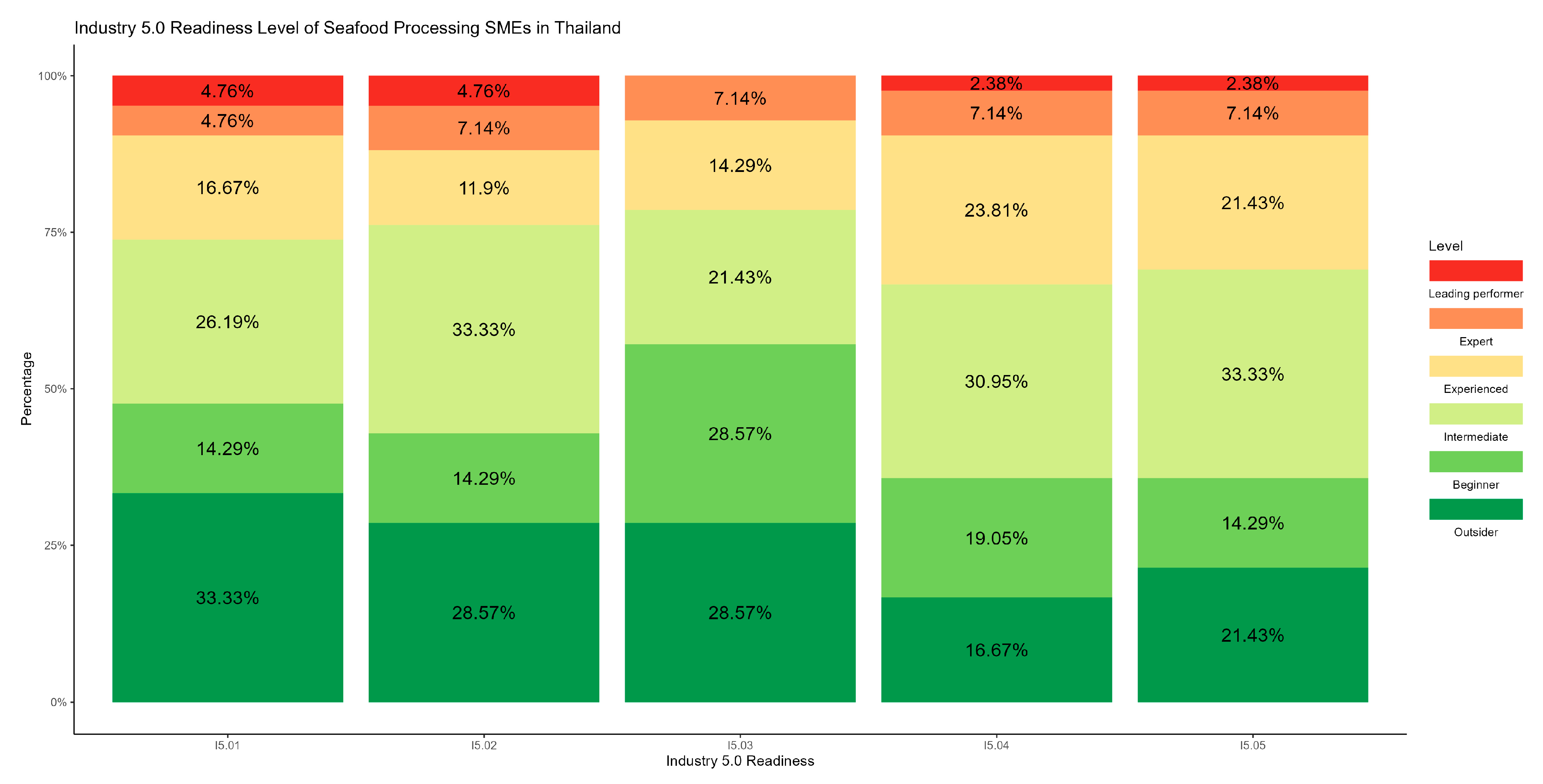
| S. No | Industry 1.0 | Industry 2.0 | Industry 3.0 | Industry 4.0 | Industry 5.0 |
|---|---|---|---|---|---|
| Production Line | |||||
| 1. | manual/semi-mechanized production | semi-automatic assembly line | automated assembly line | smart connectivity | human-centric automation |
| Major Energy Source | |||||
| 2. | coal | petroleum products | electricity | electricity + renewable Energy | renewable energy |
| Seafood processing | |||||
| 3. | sun drying | use chemical composition as preservatives and manual machinery for drying, freezing, and pasteurization | electronic and semi-automated machinery for vacuum processing, drying, freezing, and pasteurization | fully automated machinery for drying, freezing, and pasteurization | fully digitalized smart machinery for drying, freezing, and pasteurization, with sustainable practices to reduce negative economic, environmental, and social impacts |
| Packaging | |||||
| 4. | manual hermetic sealing process | semi-automatic machinery | vacuum and modern packaging technology | automatic canning/packaging machinery | IOT-based automatic canning/packaging machinery with eco-friendly packaging materials |
| Labelling | |||||
| 5. | traditional black & white handwritten labelling | traditional color printed and handwritten labelling | computerized digital printing | smart labelling (RFID) | eco-friendly smart labelling |
| Anti-bacterial testing methods, sensory, texture analyzing and quality control | |||||
| 6. | human sensory | manual food laboratory | computerized food laboratory | smart food laboratory | smart food laboratory (IoT, AI, and cloud-based solutions) |
| adoption of HACCP Standards | |||||
| Business process, documentation, and communication | |||||
| 7. | oral communication and day-to-day instructions | written communication and practicing division of labor | use of computerized software (ERP) and work order systems | use of integrated e-system, ERP, and big data analytics for internal and external communication | adopting and using human-centric approaches in automated business processes and management practices, integrated cloud-based e-systems for business openness, market orientation and traceability throughout value chain along with lean management practices and resilience plans |
| Label | Industry 1.0 | ||||||
|---|---|---|---|---|---|---|---|
| Level | 0 | 1 | 2 | 3 | 4 | 5 | |
| 11.01 | Production Line | ||||||
| Manual/semi-mechanized | 35.71 | 19.05 | 16.67 | 14.29 | 9.52 | 4.76 | |
| 11.02 | Major Energy Source | ||||||
| Coal | 83.33 | 7.14 | 4.76 | 2.38 | 2.38 | 0 | |
| I1.03 | Seafood processing | ||||||
| Sun drying | 76.19 | 9.52 | 7.14 | 2.38 | 4.76 | 0 | |
| I1.04 | Packaging | ||||||
| Manual hermetic sealing process | 16.67 | 30.95 | 14.29 | 11.9 | 14.29 | 11.9 | |
| I1.05 | Business process, documentation, and communication | ||||||
| Oral communication and day-to-day instructions | 7.14 | 14.29 | 30.95 | 23.81 | 19.05 | 4.76 | |
| Industry 1.0 Percentage Average | 43.81 | 16.2 | 14.76 | 10.95 | 10.0 | 4.28 | |
| Label | Industry 2.0 | ||||||
|---|---|---|---|---|---|---|---|
| Level | 0 | 1 | 2 | 3 | 4 | 5 | |
| Production Line | |||||||
| I2.01 | Semi-automatic assembly Line | 19.05 | 14.29 | 28.57 | 19.05 | 11.9 | 7.14 |
| Major Energy Source | |||||||
| I2.02 | Fossil fuel (Diesel/Kerosene/LPG) | 42.86 | 9.52 | 21.43 | 2.38 | 16.67 | 7.14 |
| Seafood processing | |||||||
| I2.03 | Preservatives | 35.71 | 14.29 | 16.67 | 14.29 | 4.76 | 14.29 |
| I2.04 | Refrigerators and ovens | 26.19 | 7.14 | 21.43 | 23.81 | 7.14 | 14.29 |
| Packaging | |||||||
| I2.05 | Semi-automatic machineries | 19.05 | 16.67 | 23.81 | 14.29 | 14.29 | 11.9 |
| Business process, documentation, and communication | |||||||
| I2.06 | Division of labor | 16.67 | 16.67 | 19.05 | 23.81 | 11.9 | 11.9 |
| I2.07 | Written communication | 19.05 | 16.67 | 21.43 | 16.67 | 11.9 | 14.29 |
| Industry 2.0 Percentage Average | 25.51 | 13.61 | 21.77 | 16.33 | 11.22 | 11.56 | |
| Label | Industry 3.0 | ||||||
|---|---|---|---|---|---|---|---|
| Level | 0 | 1 | 2 | 3 | 4 | 5 | |
| 13.01 | Production Line | ||||||
| Automated assembly line | 30.95 | 23.81 | 16.67 | 16.67 | 4.76 | 7.14 | |
| 13.02 | Major Energy Source | ||||||
| Electricity + renewable energy | 45.24 | 16.67 | 23.81 | 9.52 | 2.38 | 2.38 | |
| I3.03 | Seafood processing | ||||||
| Computerized machineries | 50 | 19.05 | 7.14 | 7.14 | 11.9 | 4.76 | |
| I3.04 | Advanced dry freezers | 38.1 | 19.05 | 16.67 | 16.67 | 4.76 | 4.76 |
| I3.05 | Packaging | ||||||
| Vacuum packaging | 40.48 | 26.19 | 21.43 | 4.76 | 4.76 | 2.38 | |
| I3.06 | Other modern packaging technologies | 33.33 | 33.33 | 16.67 | 7.14 | 7.14 | 2.38 |
| I3.07 | Labelling | ||||||
| Digital printing | 35.71 | 21.43 | 14.29 | 11.9 | 9.52 | 7.14 | |
| I3.08 | Anti-bacterial testing methods, sensory, texture analyzing and Quality control | ||||||
| Computerized modern food laboratory | 45.24 | 19.05 | 16.67 | 4.76 | 11.9 | 2.38 | |
| I3.09 | Business process, documentation, and communication | ||||||
| New technologies and internet for communication | 30.95 | 23.81 | 26.19 | 11.9 | 2.38 | 4.76 | |
| I3.10 | Computerized work order system | 38.1 | 14.29 | 26.19 | 9.52 | 7.14 | 4.76 |
| Industry 3.0 Percentage Average | 38.81 | 21.67 | 18.57 | 10.00 | 6.66 | 4.28 | |
| Label | Industry 4.0 | ||||||
|---|---|---|---|---|---|---|---|
| Level | 0 | 1 | 2 | 3 | 4 | 5 | |
| Production Line | |||||||
| I4.01 | Fully automated (smart assembly line) | 71.43 | 7.14 | 11.9 | 4.76 | 4.76 | 0 |
| I4.02 | Fully digitalized | 54.76 | 19.05 | 14.29 | 7.14 | 4.76 | 0 |
| I4.03 | Adoption of robots in production line | 85.71 | 7.14 | 2.38 | 2.38 | 2.38 | 0 |
| - | Major Energy Source | ||||||
| Electricity + renewable energy | - | - | - | - | - | - | |
| I4.04 | Seafood processing | ||||||
| Robotic machineries in processing | 78.57 | 9.52 | 7.14 | 2.38 | 2.38 | 0 | |
| I4.05 | Eco-friendly extraction | 59.52 | 14.29 | 14.29 | 4.76 | 7.14 | 0 |
| I4.06 | High-pressure processing | 80.95 | 9.52 | 7.14 | 0 | 2.38 | 0 |
| I4.07 | Thermal and non-thermal processing and preservation technologies | 38.1 | 21.43 | 11.9 | 14.29 | 7.14 | 7.14 |
| Packaging | |||||||
| I4.08 | Automated canning/packaging | 69.05 | 14.29 | 7.14 | 4.76 | 2.38 | 2.38 |
| I4.09 | Smart vacuum processing and packaging machines | 66.67 | 23.81 | 7.14 | 0 | 2.38 | 0 |
| Labelling | |||||||
| I4.10 | Smart labelling (RFID) | 80.95 | 9.52 | 7.14 | 2.38 | 0 | 0 |
| Anti-bacterial testing methods, sensory, texture analyzing, and quality control | |||||||
| I4.11 | Sensory and texture analyzing machineries | 80.95 | 7.14 | 9.52 | 0 | 2.38 | 0 |
| I4.12 | AI technologies in food sensing | 69.05 | 21.43 | 7.14 | 0 | 2.38 | 0 |
| I4.13 | Business process, documentation, and communication | ||||||
| ERP systems | 76.19 | 4.76 | 7.14 | 4.76 | 7.14 | 0 | |
| I4.14 | Big data to analyze consumer demand and consumer behavior | 61.9 | 16.67 | 7.14 | 9.52 | 4.76 | 0 |
| I4.15 | E-system or software for communicating with internal employees and external suppliers | 40.48 | 23.81 | 16.67 | 11.9 | 4.76 | 2.38 |
| Industry 4.0 Percentage Average | 67.62 | 13.97 | 9.21 | 4.6 | 3.81 | 0.79 | |
| Label | Industry 5.0 | ||||||
|---|---|---|---|---|---|---|---|
| Level | 0 | 1 | 2 | 3 | 4 | 5 | |
| Production Line | |||||||
| - | - | - | - | - | - | - | - |
| Major Energy Source | |||||||
| - | - | - | - | - | - | - | - |
| Seafood processing | |||||||
| - | - | - | - | - | - | - | - |
| Packaging | |||||||
| - | - | - | - | - | - | - | - |
| Labelling | |||||||
| - | - | - | - | - | - | - | - |
| Anti-bacterial testing methods, sensory, texture analyzing and quality control | |||||||
| - | - | - | - | - | - | - | - |
| Business process, documentation, and communication | |||||||
| I5.01 | Human-centric management practices | 33.33 | 14.29 | 26.19 | 16.67 | 4.76 | 4.76 |
| I5.02 | Fair trade practices | 28.57 | 14.29 | 33.33 | 11.9 | 7.14 | 4.76 |
| I5.03 | Lean management | 28.57 | 28.57 | 21.43 | 14.29 | 7.14 | 0 |
| I5.04 | Sustainability practices | 16.67 | 19.05 | 30.95 | 23.81 | 7.14 | 2.38 |
| I5.05 | Resilience ready | 21.43 | 14.29 | 33.33 | 21.43 | 7.14 | 2.38 |
| Industry 5.0 Percentage Average | 25.71 | 18.10 | 29.05 | 17.62 | 6.66 | 2.86 | |
Disclaimer/Publisher’s Note: The statements, opinions and data contained in all publications are solely those of the individual author(s) and contributor(s) and not of MDPI and/or the editor(s). MDPI and/or the editor(s) disclaim responsibility for any injury to people or property resulting from any ideas, methods, instructions or products referred to in the content. |
© 2024 by the authors. Licensee MDPI, Basel, Switzerland. This article is an open access article distributed under the terms and conditions of the Creative Commons Attribution (CC BY) license (https://creativecommons.org/licenses/by/4.0/).
Share and Cite
Madhavan, M.; Sharafuddin, M.A.; Wangtueai, S. Measuring the Industry 5.0-Readiness Level of SMEs Using Industry 1.0–5.0 Practices: The Case of the Seafood Processing Industry. Sustainability 2024, 16, 2205. https://doi.org/10.3390/su16052205
Madhavan M, Sharafuddin MA, Wangtueai S. Measuring the Industry 5.0-Readiness Level of SMEs Using Industry 1.0–5.0 Practices: The Case of the Seafood Processing Industry. Sustainability. 2024; 16(5):2205. https://doi.org/10.3390/su16052205
Chicago/Turabian StyleMadhavan, Meena, Mohammed Ali Sharafuddin, and Sutee Wangtueai. 2024. "Measuring the Industry 5.0-Readiness Level of SMEs Using Industry 1.0–5.0 Practices: The Case of the Seafood Processing Industry" Sustainability 16, no. 5: 2205. https://doi.org/10.3390/su16052205
APA StyleMadhavan, M., Sharafuddin, M. A., & Wangtueai, S. (2024). Measuring the Industry 5.0-Readiness Level of SMEs Using Industry 1.0–5.0 Practices: The Case of the Seafood Processing Industry. Sustainability, 16(5), 2205. https://doi.org/10.3390/su16052205







